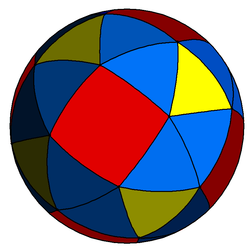Square on a Sphere
 A square is drawn on the surface of a sphere. The radius of the sphere is 100. If each interior angle of the square measures 100 degrees, what is the area of the spherical square?
A square is drawn on the surface of a sphere. The radius of the sphere is 100. If each interior angle of the square measures 100 degrees, what is the area of the spherical square?
The answer is 6981.32.
This section requires Javascript.
You are seeing this because something didn't load right. We suggest you, (a) try
refreshing the page, (b) enabling javascript if it is disabled on your browser and,
finally, (c)
loading the
non-javascript version of this page
. We're sorry about the hassle.

We'll divide the square into two equal triangles and calculate their area. Then, the angles of the triangles are α = β = 5 0 ∘ , γ = 1 0 0
Note that the area of a spherical triangle depends only on the sum of the interior angles and the radius of the sphere, by the formula:
a r e a ( t r i a n g l e ) = R 2 ( α + β + γ − π )
Hence, a r e a ( s q u a r e ) = 2 ∗ 1 0 0 2 ∗ ( ( 2 0 / 1 8 0 ) ∗ π ) ≈ 6 9 8 1 . 3 1 7 ⇒ 6 9 8 1 . 3 2
Now, where does the formula come from?
We have to imagine how the sides of a triangle divide the sphere. Let ABC be a spherical triangle. The sides of the triangle determine three great circumferences on the sphere. Then, the triangle ABC and the opposite triangle across the segment BC form a lune, L a , ABC and the opposite triangle across AC form another lune L b and ABC and the opposite triangle across AB form another lune L c . Notice that each lune has an opposite lune equal in area (because two great circumferences determine two equal lunes) and those cover the rest of the sphere, so the area covered by the three lunes is half the area of the sphere. Hence,
2 π R 2 = ( a r e a ( L a ) − a r e a ( A B C ) ) + ( a r e a ( L b ) − a r e a ( A B C ) ) + ( a r e a ( L c ) − a r e a ( A B C ) ) + a r e a ( A B C ) 2 π R 2 = a r e a ( L a ) + a r e a ( L b ) + a r e a ( L c ) − 2 a r e a ( A B C )
Also, the area of each lune is proportional to its angle, so
2 π R 2 = 2 α R 2 + 2 β R 2 + 2 γ R 2 − 2 a r e a ( A B C )
a r e a ( A B C ) = R 2 ( α + β + γ − π )